Black-bellied Pangolin
- February 22, 2024
- 0 comment
The Black-bellied pangolin, also known as the long-tailed pangolin, is a fascinating mammal native to Africa. Sporting a unique appearance with its dark brown to black scales made of keratin, this creature is renowned for its ability to curl into a ball when threatened, using its sharp-scaled tail as protection. With a length ranging from 30 to 60 centimeters, and its tail comprising about half of its total length, the Black-bellied pangolin is a distinctive sight in its habitat. Found across Central and West Africa, including countries like Cameroon, Gabon, and Nigeria, this species inhabits diverse ecosystems, from forests to grasslands.
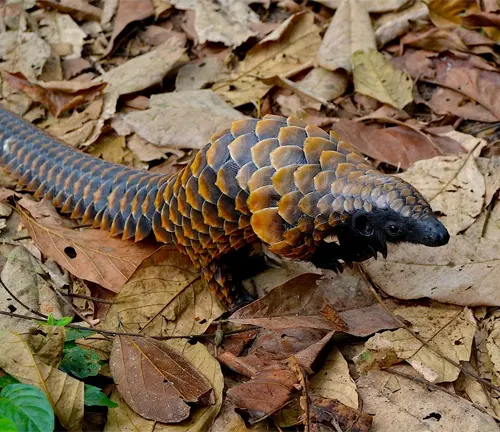
Primarily insectivorous, the Black-bellied pangolin feeds on ants and termites, playing a crucial role in controlling insect populations and maintaining ecosystem balance. Despite its ecological importance, the Black-bellied pangolin faces significant threats, including habitat loss, poaching for its scales, and illegal wildlife trade. Conservation efforts are essential to safeguard this species and ensure its continued presence in the wild.
| Aspect | Description |
|---|---|
| Scientific Name | Phataginus tetradactyla |
| Common Names | Black-bellied pangolin, Long-tailed pangolin |
| Length | 30 – 60 centimeters |
| Weight | Up to 7 kilograms |
| Color | Dark brown to black scales |
| Distribution | Central and West Africa |
| Habitat | Forests, savannas, grasslands |
| Diet | Primarily ants and termites |
| Conservation Status | Vulnerable |
| Threats | Habitat loss, poaching, illegal wildlife trade |
| Reproduction | Single offspring after several months of gestation |
| Unique Features | Ability to curl into a ball for protection, long, sticky tongue for capturing prey |
A Fascinating Creature Under Threat
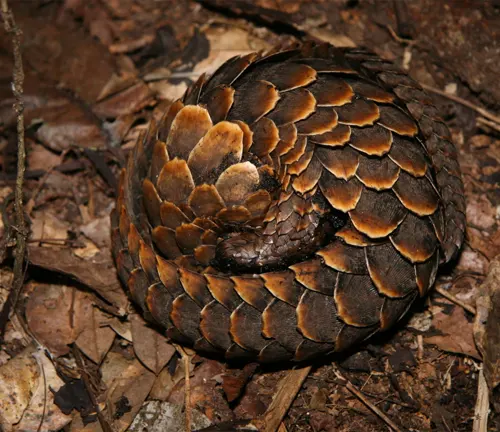
Pangolins are unique creatures that often elicit curiosity and wonder. Among the various pangolin species, the black-bellied pangolin stands out with its distinctive characteristics and ecological importance. In this article, we delve into the world of the black-bellied pangolin, exploring its habitat, behavior, conservation status, and the challenges it faces in the wild.
The black-bellied pangolin (Phataginus tetradactyla) is one of the four species of pangolins found in Africa. Also known as the long-tailed pangolin, it is characterized by its elongated body covered in tough, overlapping scales made of keratin.
Physical Characteristics
Black-bellied pangolins typically have a length ranging from 30 to 60 centimeters, with their tail comprising about half of their total length. Their scales are dark brown to black, giving them their distinctive appearance. These scales provide protection against predators, and when threatened, the pangolin curls into a ball, using its sharp-scaled tail as a shield.
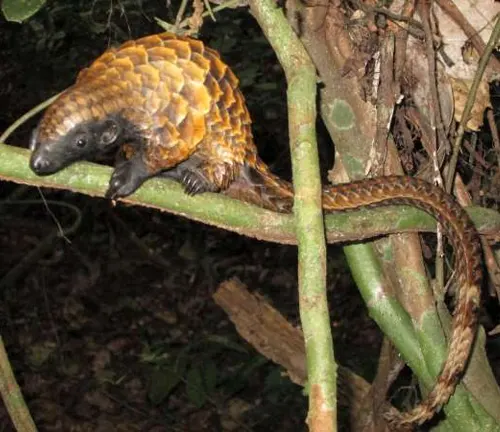
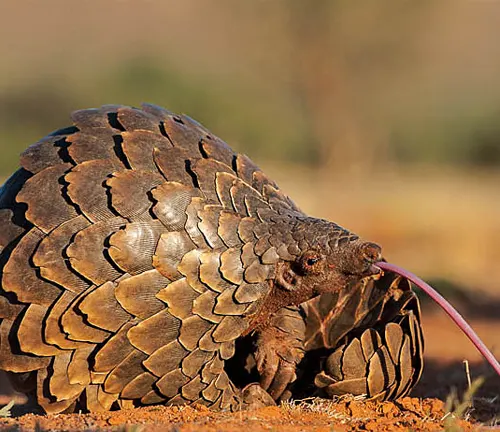
- Scales: The body of the Black-bellied pangolin is covered in tough, overlapping scales made of keratin, the same material found in human fingernails. These scales are dark brown to black in color, providing protection against predators.
- Body Shape: The pangolin has a cylindrical body with a slightly tapered snout. It has a relatively small head compared to its body size.
- Size: Black-bellied pangolins typically measure between 30 to 60 centimeters in length, with their tail comprising about half of their total length.
- Tail: One of the distinctive features of the Black-bellied pangolin is its long, prehensile tail. This tail is covered in sharp, overlapping scales and is used for balance and climbing.
- Claws: The pangolin has powerful claws on its front and hind limbs, which it uses for digging burrows, tearing into termite mounds, and climbing trees.
- Eyes and Ears: Black-bellied pangolins have small, beady eyes and ears, which are often concealed beneath their scales when they curl up into a defensive ball.
- Tongue: Their long, sticky tongue is another notable feature. It can extend up to 40 centimeters and is used to lap up ants, termites, and other insects from nests and crevices.
Habitat and Distribution
These pangolins inhabit a variety of ecosystems, including forests, savannas, and grasslands, across Central and West Africa. They are predominantly found in countries such as Cameroon, Gabon, Nigeria, and the Democratic Republic of the Congo.
Habitat
Black-bellied pangolins are adaptable creatures that can be found in a range of habitats, including:
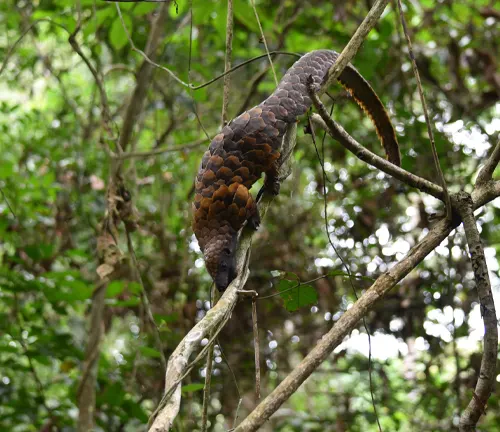

- Forests: They inhabit both tropical rainforests and dry forests, where they forage for insects among the dense vegetation.
- Savannas: Black-bellied pangolins are also found in savanna habitats, where they can access open areas for foraging while utilizing trees and shrubs for shelter.
- Grasslands: In some regions, they venture into grassland areas, especially where there are termite mounds and other insect-rich environments.
Distribution
The distribution of Black-bellied pangolins covers several countries in Central and West Africa, including but not limited to:
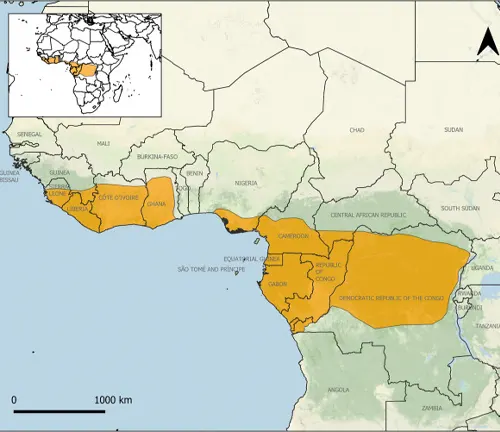
- Cameroon: Black-bellied pangolins are found throughout Cameroon, where they inhabit a variety of habitats from dense forests to open savannas.
- Gabon: They are also present in Gabon, where they can be found in national parks and protected areas.
- Nigeria: In Nigeria, Black-bellied pangolins are distributed across the country, although their populations may be threatened by habitat loss and poaching.
- Democratic Republic of the Congo (DRC): They inhabit parts of the DRC, where they face similar challenges due to human encroachment and illegal wildlife trade.
Diet and Feeding Behavior
Black-bellied pangolins are primarily insectivorous, feeding on ants and termites. Using their strong claws, they excavate insect nests and use their long, sticky tongues to capture prey. This specialized diet makes them essential for controlling insect populations, playing a crucial role in ecosystem balance.
Diet

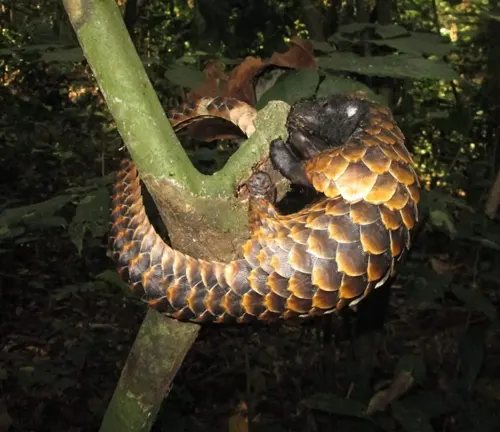
- Ants: Ants are a staple food source for Black-bellied pangolins. They are known to raid ant nests and consume large numbers of ants during foraging.
- Termites: Termites are another important part of the Black-bellied pangolin’s diet. They will break into termite mounds to access the insects inside, using their powerful claws and long tongues to extract the termites.
- Other Insects: In addition to ants and termites, Black-bellied pangolins may also consume other insects such as beetles, larvae, and ants’ eggs when available.
Feeding Behavior
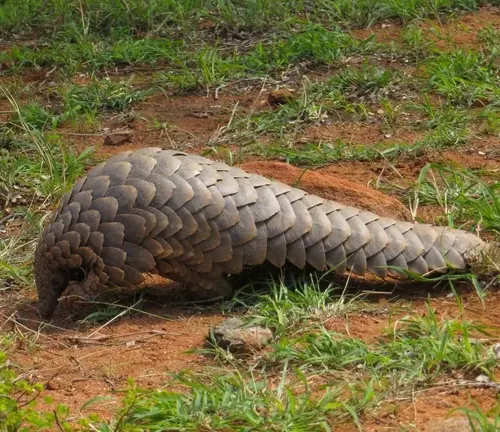
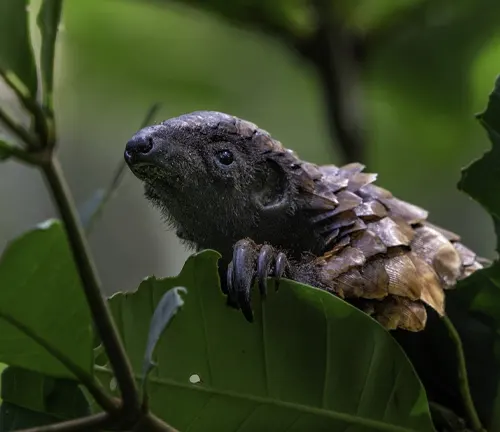
- Foraging: Black-bellied pangolins are primarily nocturnal, meaning they are most active during the night. They use their keen sense of smell to locate insect prey in their habitat.
- Digging: Using their strong claws, Black-bellied pangolins excavate burrows and tear into termite mounds to access their prey. They are skilled diggers, capable of breaking through hard soil and tree bark.
- Tongue Feeding: Once they locate their prey, Black-bellied pangolins use their long, sticky tongues to lap up insects from nests, crevices, and the ground. Their tongues can extend up to 40 centimeters, allowing them to reach deep into insect colonies.
Specialized Adaptations
- Scales: The scales covering the Black-bellied pangolin’s body provide protection against ant bites and other insect defenses.
- Prehensile Tail: While foraging in trees or navigating through vegetation, Black-bellied pangolins use their prehensile tails for balance and support.
Reproduction and Life Cycle
Breeding habits of black-bellied pangolins are not extensively studied, but like other pangolin species, they typically give birth to a single offspring after a gestation period of several months. The young pangolin is nurtured by its mother until it becomes independent.
Reproduction
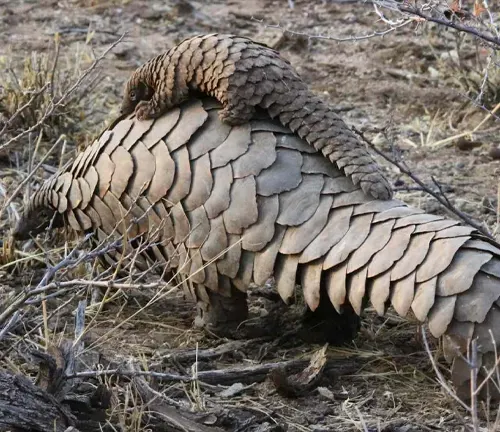

- Breeding: Black-bellied pangolins typically breed during specific times of the year, although exact breeding seasons may vary depending on factors such as habitat and food availability.
- Gestation: After mating, female Black-bellied pangolins undergo a gestation period that lasts several months. The exact duration of gestation is not precisely known and may vary among individuals.
- Birth: Female pangolins give birth to a single offspring, known as a pup, although there are rare instances of twins being born. The newborn pangolin is usually well-developed and capable of clinging to its mother’s belly.
Life Cycle
- Infancy: At birth, Black-bellied pangolin pups are small and relatively undeveloped but have soft scales that harden over time. They rely entirely on their mother for nourishment and protection during the infancy stage.
- Maternal Care: The mother provides care and protection to her offspring, carrying the young pangolin on her back or belly as she forages for food. The mother may also create a nest or burrow to shelter the pup from predators and harsh weather conditions.
- Independence: As the young pangolin grows, it gradually becomes more independent, learning essential survival skills such as foraging and defense. Eventually, it reaches maturity and ventures out on its own to establish its territory and reproduce, continuing the cycle of life.
Conservation Status
The black-bellied pangolin is classified as vulnerable by the International Union for Conservation of Nature (IUCN). Habitat loss due to deforestation, as well as poaching for their scales and meat, pose significant threats to their survival.


- Habitat Loss and Degradation: Deforestation, agricultural expansion, and urban development have led to the loss and fragmentation of the pangolin’s natural habitat. As forests are cleared for timber extraction, agriculture, and infrastructure development, pangolins lose crucial shelter and food resources.
- Illegal Wildlife Trade: Black-bellied pangolins are heavily targeted by poachers for their scales, which are used in traditional medicine, and their meat, considered a delicacy in some cultures. Despite international bans on pangolin trade, illegal trafficking continues, driven by demand from Asian markets.
- Poaching and Hunting: In addition to illegal wildlife trade, pangolins are also hunted for bushmeat consumption and traditional rituals in some African communities. Hunting pressure, combined with habitat loss, poses a significant threat to pangolin populations.
- Lack of Legal Protection: In many regions, pangolins lack adequate legal protection, making them vulnerable to exploitation and trafficking. Strengthening laws and enforcement mechanisms is essential for combating poaching and illegal trade.
Role in Traditional Medicine
Despite the lack of scientific evidence, pangolin scales are still used in traditional medicine in some cultures. Educating communities about the lack of efficacy of pangolin products is crucial for reducing demand.
Different Species
Phataginus tetradactyla
This species is commonly referred to as the Black-bellied pangolin or the Long-tailed pangolin. It is found in Central and West Africa, including countries such as Cameroon, Gabon, Nigeria, and the Democratic Republic of the Congo.

Phataginus tricuspis
This species is known as the Three-cusped pangolin or the Central African pangolin. It is also found in Central and West Africa, inhabiting similar regions as Phataginus tetradactyla.
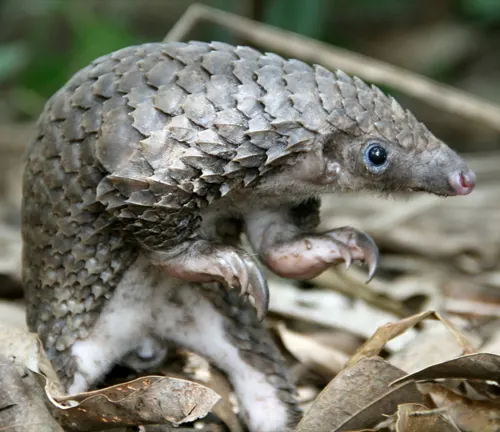
Frequently Asked Questions (FAQs)
- Are Black-bellied pangolins dangerous to humans?
Black-bellied pangolins are not aggressive towards humans and will typically roll into a ball when threatened. However, like all wild animals, they should be treated with caution and respect. - What do Black-bellied pangolins eat?
Black-bellied pangolins are primarily insectivorous, feeding on ants and termites. They use their strong claws to excavate insect nests and their long, sticky tongues to capture prey. - Where are Black-bellied pangolins found?
Black-bellied pangolins are native to Central and West Africa, including countries such as Cameroon, Gabon, Nigeria, and the Democratic Republic of the Congo. They inhabit various ecosystems, including forests, savannas, and grasslands. - Why are Black-bellied pangolins endangered?
Black-bellied pangolins are classified as vulnerable due to threats such as habitat loss, poaching for their scales and meat, and illegal wildlife trade. These factors have led to a decline in their population numbers. - How can I help protect Black-bellied pangolins?
You can support Black-bellied pangolin conservation efforts by raising awareness about their plight, supporting organizations working to combat wildlife trafficking, and avoiding products made from pangolin parts. - Can Black-bellied pangolins be kept as pets?
No, Black-bellied pangolins are wild animals and should not be kept as pets. They have specialized dietary and environmental needs that cannot be met in a domestic setting. - What is being done to conserve Black-bellied pangolins?
Conservation efforts for Black-bellied pangolins include habitat protection, law enforcement to combat poaching and trafficking, and community education initiatives to raise awareness about their conservation status. - How many species of Black-bellied pangolins are there?
There are two recognized species of Black-bellied pangolins: Phataginus tetradactyla and Phataginus tricuspis. Both species share similar habitats and face similar conservation threats. - What role do Black-bellied pangolins play in ecosystems?
Black-bellied pangolins play a crucial role in ecosystems by controlling insect populations, which helps maintain ecological balance. Their burrowing behavior also contributes to soil health and nutrient cycling. - Are Black-bellied pangolins nocturnal?
Yes, Black-bellied pangolins are primarily nocturnal, meaning they are most active during the night. They spend their days resting in burrows or trees to avoid predators and extreme temperatures.


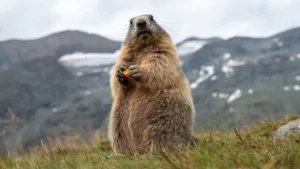
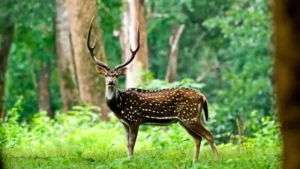
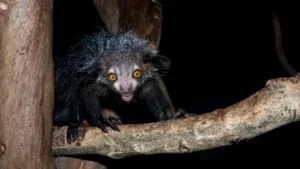


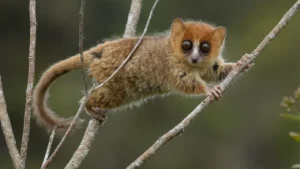
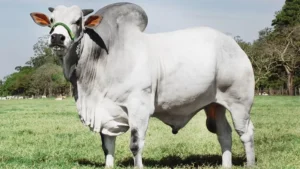
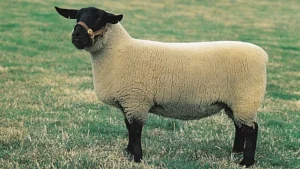
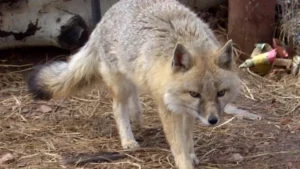
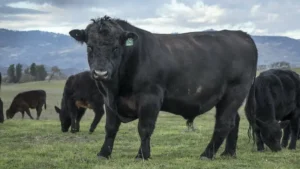
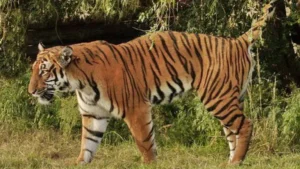
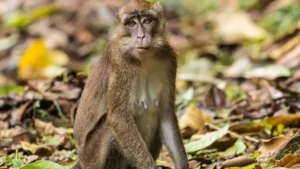
Leave your comment